In-Process Measurement for the Process Control of the Real-Time Manufacturing of Tapered Roller Bearings
Abstract
:1. Introduction
2. Materials and Methods
3. Results
3.1. Effect of Temperature on Measurement
3.2. Effect of Process and Machine Factors on the Measurement
3.3. Estimation of the Uncertainty and Contribution of Each Parameter
4. Discussion
5. Conclusions
Author Contributions
Funding
Conflicts of Interest
Nomenclature
| Ta,m (°C) | Ambient temperature when measuring the m-th piece. |
| Ta,0 (°C) | Ambient temperature when measuring the master piece. |
| Ts,m (°C) | System temperature when measuring the m-th piece. |
| Ts,0 (°C) | System temperature when measuring the master piece. |
| Tm,m (°C) | Measurand temperature when measuring the m-th piece. |
| Tm,0 (°C) | Measurand temperature when measuring the master piece. |
| Tc (°C) | Temperature from the contact thermometer (used in the Monte Carlo simulation). |
| Ta (°C) | Temperature from the ambient thermometer (used in the Monte Carlo simulation). |
| Hs,m (mm) | Tooling height of the system (see Figure 2) when measuring the m-th piece. |
| Hs,0 (mm) | Tooling height of the system (see Figure 2) when measuring the master piece. |
| H (mm) | Tooling height of the system at 20 °C. |
| Lm,m (mm) | Probe length when measuring the m-th piece. |
| L0,m (mm) | Probe length from the measurement of the master piece but when measuring the m-th piece. |
| L0,0 (mm) | Probe length when measuring the master piece. |
| Lm (mm) | Probe length when measuring the m-th piece (dimension at 20 °C). |
| L0 (mm) | Probe length when measuring the master piece (dimension at 20 °C). |
| Dm,m (mm) | Measurand (diameter) of the m-th piece at the moment of measure it. |
| D0,m (mm) | Measurand (diameter) of the master piece at the moment of measure the m-th piece. |
| D0,0 (mm) | Measurand (diameter) of the master piece at the moment of measure it. |
| Dm (mm) | Measurand (diameter) of the m-th piece (dimension at 20 °C). |
| D0 (mm) | Measurand (diameter) of the master piece (dimension at 20 °C). |
| ΔLm (mm) | Figure, at 20 °C, of the difference between L0,m and Lm,m, see Equations (8) and (9). |
| θm (°) | Angle between a vertical line and the front face of the ring (see Figure 4) when measuring the m-th piece. |
| θ0 (°) | Angle between a vertical line and the front face of the ring (see Figure 4) when measuring the master piece. |
| ψm (°) | Angle between a vertical line and the axis of the contact prober of the comparator dial when measuring the m-th piece (see Figure 5). |
| ψ0 (°) | Angle between a vertical line and the axis of the contact prober of the comparator dial when measuring the master piece (see Figure 5). |
| λm (°) | Linear translation on X-axis direction (see Figure 5) when measuring the m-th piece. |
| λ0 (°) | Linear translation on X-axis direction (see Figure 5) when measuring the master piece. |
| αm (°C−1) | Thermal expansion coefficient of the m-th piece. |
| α0 (°C−1) | Thermal expansion coefficient of the master piece. |
| αs (°C−1) | Thermal expansion coefficient of the system. |
References
- El-Thalji, I.; Jantunen, E. A summary of fault modelling and predictive health monitoring of rolling element bearings. Mech. Syst. Signal Process. 2015, 60–61, 252–272. [Google Scholar] [CrossRef]
- Liu, J.; Shao, Y.; Qin, X. Dynamic simulation for a tapered roller bearing considering a localized surface fault on the rib of the inner race. Proc. Inst. Mech. Eng. Part K 2017, 231, 670–683. [Google Scholar] [CrossRef]
- Wee, D.; Kelly, R.; Cattel, J.; Breunig, M. Industry 4.0: How to Navigate Digitization of the Manufacturing Sector. Available online: https://www.mckinsey.com/~/media/McKinsey/Business%20Functions/Operations/Our%20Insights/Industry%2040%20How%20to%20navigate%20digitization%20of%20the%20manufacturing%20sector/Industry-40-How-to-navigate-digitization-of-the-manufacturing-sector.ashx (accessed on 20 July 2018).
- D’Addona, D.M.; Bracco, F.; Bettoni, A.; Nishino, N.; Carpanzano, N.; Bruzzone, A.A. Adaptive automation and human factors in manufacturing: An experimental assessment for a cognitive approach. CIRP Ann. 2018, 67, 455–458. [Google Scholar] [CrossRef]
- Finlay, B.; Rackwitz, N.; Conerney, B.; Warren, E.; Erdmann, D.; Stoddard, K.; Weber, A.; Scanlon, T. Requirements for First-Time-Right Response in Advanced Manufacturing. In Proceedings of the 29th Annual SEMI Advanced Semiconductor Manufacturing Conference (ASMC), Saratoga Springs, NY, USA, 30 April–3 May 2018; pp. 186–188. [Google Scholar]
- Fraunhofer IPA. Statista—Das Statistik-Portal, Worin sehen Sie konkrete Bedarfe an Intelligenten Lösungen im Produktionsalltag; Fraunhofer IPA: Hamburg, Germany, 2016; Available online: https://de.statista.com/statistik/daten/studie/605169/umfrage/bedarf-an-intelligenten-loesungen-im-produktionsalltag-im-deutschen-mittelstand/ (accessed on 20 July 2018).
- Horváth & Partners. Statista—Das Statistik-Portal, Welche Industrie 4.0-Technologien Sind Heute Bzw. Werden Zukünftig in Unternehmen von Bedeutung Sein; Horváth & Partners: Hamburg, Germany, 2015; Available online: https://de.statista.com/statistik/daten/studie/606952/umfrage/bedeutung-von-technologien-der-industrie-40-heute-und-zukuenftig-in-der-dach-region/ (accessed on 20 July 2018).
- Colledani, M.; Fischer, A.; Iung, B.; Lanza, G.; Schmitt, R.; Tolio, T.; Vancza, J. Design and management of manufacturing systems for production quality. CIRP Ann. Manuf. Technol. 2014, 63, 773–796. [Google Scholar] [CrossRef]
- Jurko, J.; Panda, A.; Valíček, J.; Harničárová, M.; Pandová, I. Study on cone roller bearing surface roughness improvement and the effect of surface roughness on tapered roller bearing service life. Int. J. Adv. Manuf. Technol. 2016, 82, 1099–1106. [Google Scholar] [CrossRef]
- Weckenmann, A.; Estler, T.; Peggs, G.; McMurtry, D. Probing systems in dimensional metrology. CIRP Ann. Manuf. Technol. 2004, 53, 657–684. [Google Scholar] [CrossRef]
- Neugebauer, M.; Lüdicke, F.; Bastam, D.; Bosse, H.; Reimann, H.; Töpperwien, C. A new comparator for measurement of diameter and form of cylinders, spheres and cubes under clean-room conditions. Meas. Sci. Technol. 1997, 8, 849. [Google Scholar] [CrossRef]
- Olczyk, A.; Magiera, R.; Kabalyk, K. A 2-port, space-saving, maintenance-friendly pneumatic probe for velocity measurements. Metrol. Meas. Syst. 2018, 1, 171–185. [Google Scholar]
- Crnojevic, C.; Roy, G.; Bettahar, A.; Florent, P. The Influence of the Regulator Diameter and Injection Nozzle Geometry on the Flow Structure in Pneumatic Dimensional Control Systems. J. Fluids Eng. 1997, 119, 609–615. [Google Scholar] [CrossRef]
- Hoffrogge, C.; Mann, R. Measuring Laser Inferometer Device for Inside and Outside Dimensions. Messtechnik 1973, 81, 1–6. [Google Scholar]
- Kim, J.A.; Kim, J.W.; Kang, C.S.; Eom, T.B. An interferometric Abbe-type comparator for the calibration of internal and external diameter standards. Meas. Sci. Technol. 2010, 21, 75–109. [Google Scholar] [CrossRef]
- Chen, Y.; He, Z.; Yang, S. Research on On-Line Automatic Diagnostic Technology for Scratch Defect of Rolling Element Bearings. Int. J. Precis. Eng. Manuf. 2012, 13, 357–362. [Google Scholar] [CrossRef]
- Kumar, R.; Singh, M. Outer race defect width measurement in taper roller bearing using discrete wavelet transform of vibration signal. Measurement 2012, 46, 537–545. [Google Scholar] [CrossRef]
- Deák, K.; Mankovits, T.; Kocsis, I. Optimal Wavelet Selection for the Size Estimation of Manufacturing Defects of Tapered Roller Bearings with Vibration Measurement using Shannon Entropy Criteria. Stroj. Vestnik J. Mech. Eng. 2017, 63, 3–14. [Google Scholar] [CrossRef]
- Chen, M.; Wang, C.; An, Q.; Ming, W. Tool path strategy and cutting process monitoring in intelligent machining. Front. Mech. Eng. 2018, 13, 232–242. [Google Scholar] [CrossRef]
- Zhou, M.; Zheng, G.; Chen, S. Identification and looping tool path generation for removing residual areas left by pocket roughing. Int. J. Adv. Manuf. Technol. 2016, 87, 765–778. [Google Scholar] [CrossRef]
- Gao, X.; Mou, W.; Peng, Y. An intelligent process planning method based on feature-based history machining data for aircraft structural parts. Procedia CIRP 2016, 56, 585–589. [Google Scholar] [CrossRef]
- Tönshoff, H.K.; Friemuth, T.; Becker, J.C. Process Monitoring in Grinding. CIRP Ann. Manuf. Technol. 2002, 51, 551–571. [Google Scholar] [CrossRef]
- Shiraishi, M. Scope of in-process measurement, monitoring and control techniques in machining processes—Part 3: In-process techniques for cutting processes and machine tools. Precis. Eng. 1989, 11, 39–47. [Google Scholar] [CrossRef]
- Brosed, F.J.; Aguilar, J.J.; Santolaria, J.; Lázaro, R. Geometrical verification based on a laser triangulation system in industrial environment. Effect of the image noise in the measurement results. Procedia Eng. 2015, 132, 764–771. [Google Scholar] [CrossRef]
- Jalid, A.; Hariri, S.; El Gharad, A.; Senelaer, J.P. Comparison of the GUM and Monte Carlo methods on the flatness uncertainty estimation in coordinate measuring machine. Int. J. Metrol. Qual. Eng. 2016, 7, 302. [Google Scholar] [CrossRef] [Green Version]
- Forbes, A.B.; Mengot, A.; Jonas, K. Uncertainty associated with coordinate measurement in comparator mode. In Proceedings of the Laser Metrology and Machine Performance XI, Huddersfield, UK, 17–18 March 2015; pp. 150–159. [Google Scholar]
- BIPM; IEC; IFCC; ILAC; ISO; IUPAC; IUPAP; OIML. Evaluation of Measurement Data—Guide to the Expression of Uncertainty in Measurement; JCGM 100: Bureau International des Poids et Mesures (BIPM): Sèvres, France, 2008. [Google Scholar]
- BIPM; IEC; IFCC; ILAC; ISO; IUPAC; IUPAP; OIML. Evaluation of Measurement Data—Supplement 1 to the “Guide to the Expression of Uncertainty in Measurement”—Propagation of Distributions Using a Monte Carlo Method; JCGM 101: Bureau International des Poids et Mesures (BIPM): Sèvres, France, 2008. [Google Scholar]
- Eichstädt, S.; Link, A.; Harris, P.M.; Elster, C. Efficient implementation of a Monte Carlo method for uncertainty evaluation in dynamic measurements. Metrologia 2012, 49, 401–410. [Google Scholar] [CrossRef]
- Los, A.; Mayer, J.R.R. Application of the adaptive Monte Carlo method in a five-axis machine tool calibration uncertainty estimation including the thermal behavior. Precis. Eng. 2018, 53, 17–25. [Google Scholar] [CrossRef]
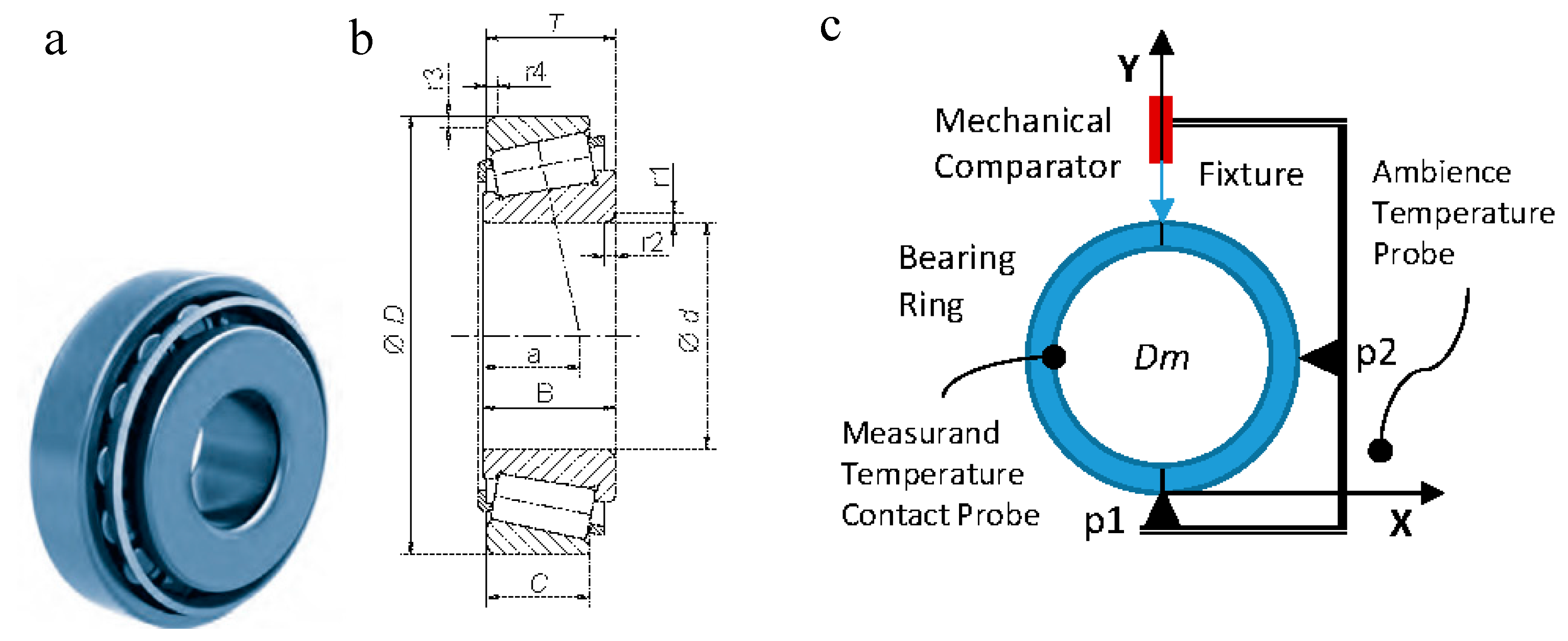
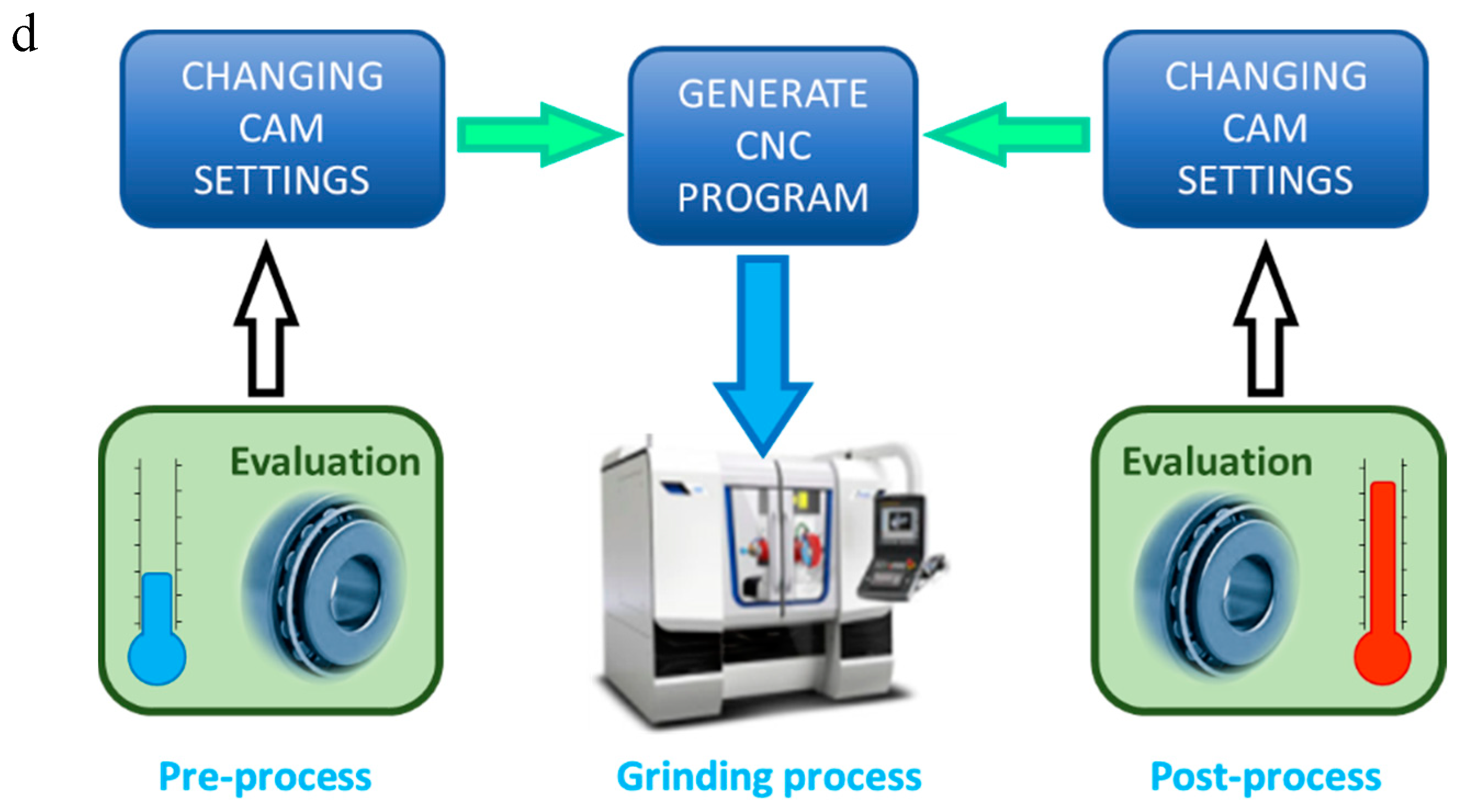
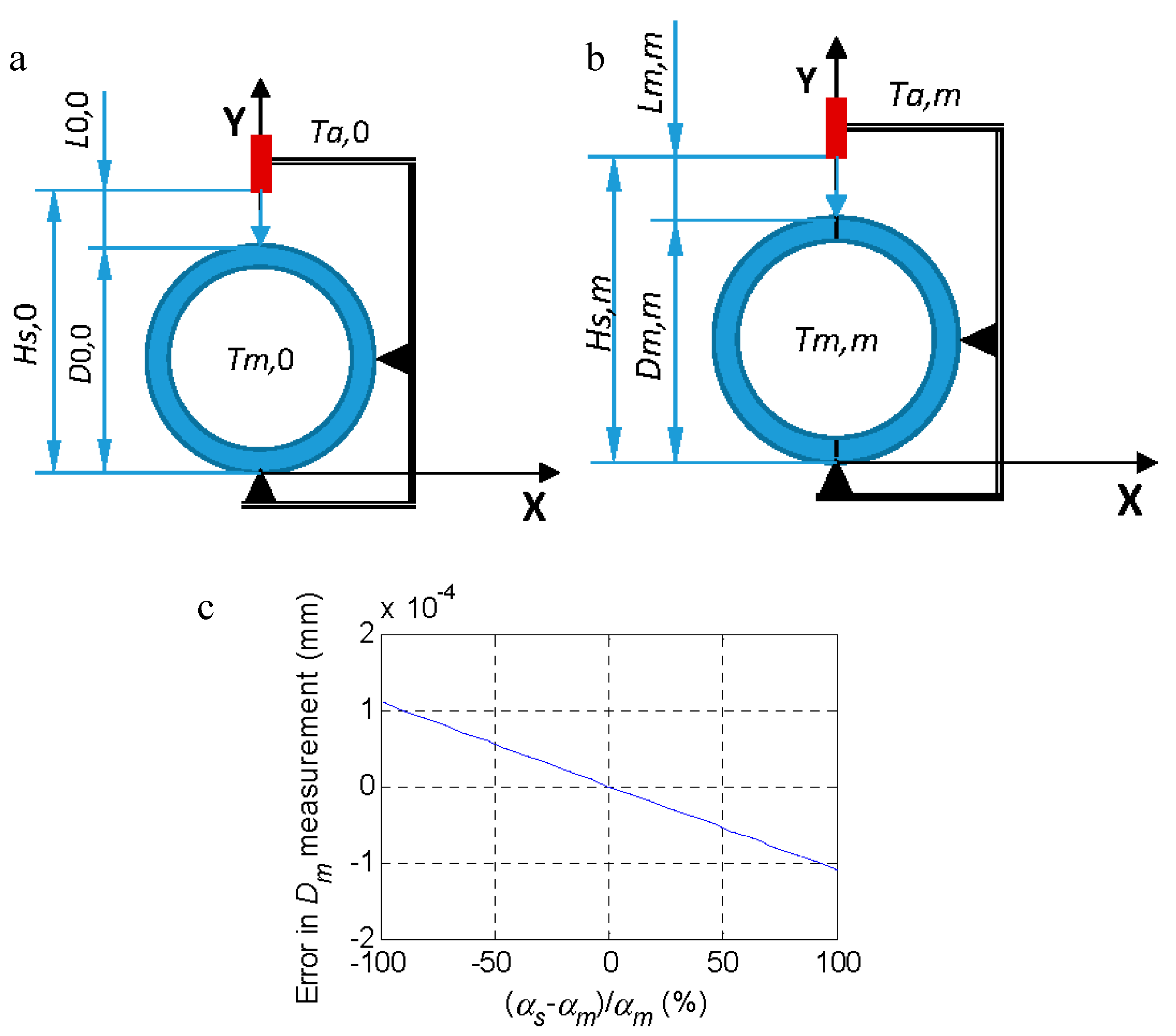


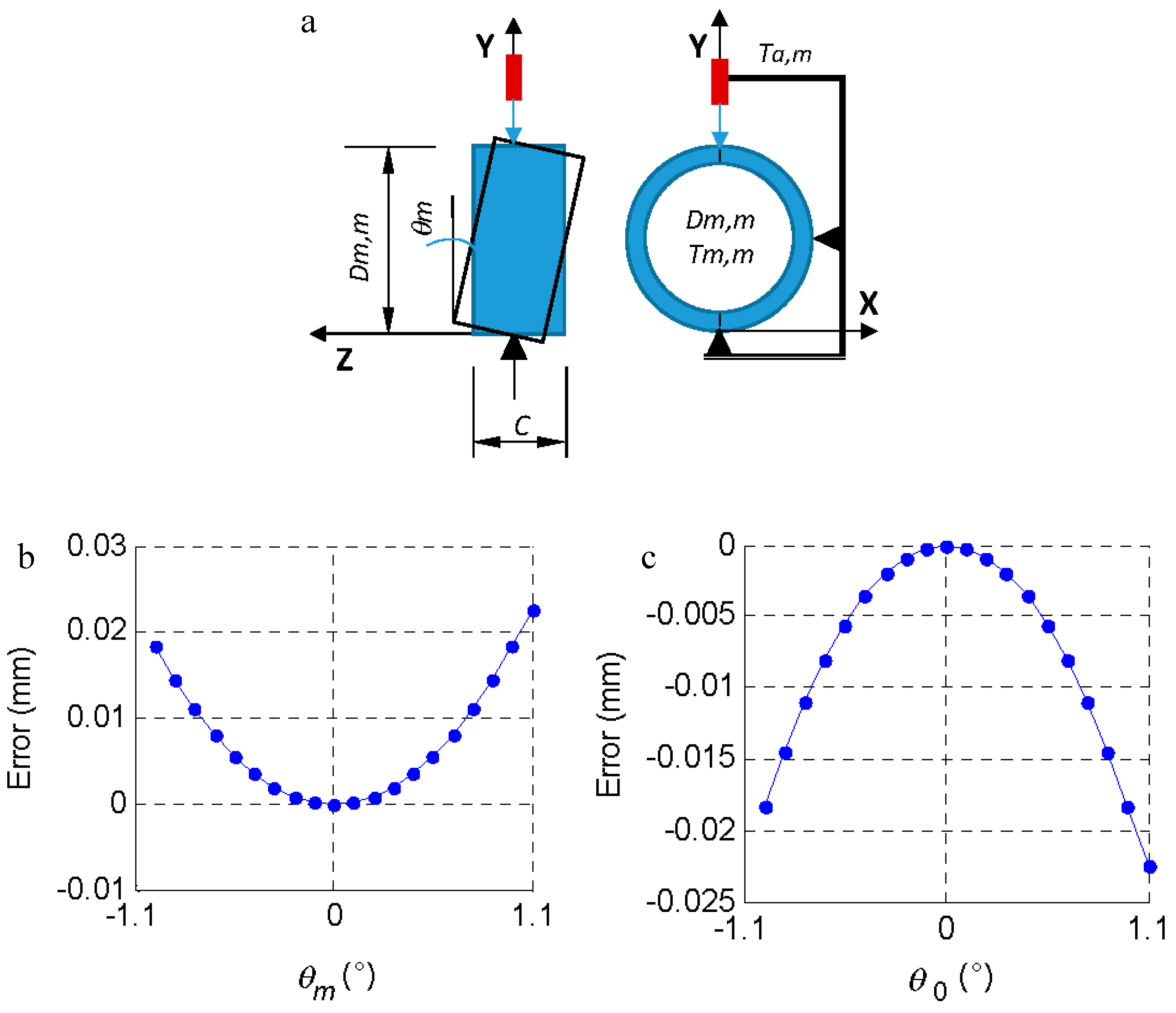
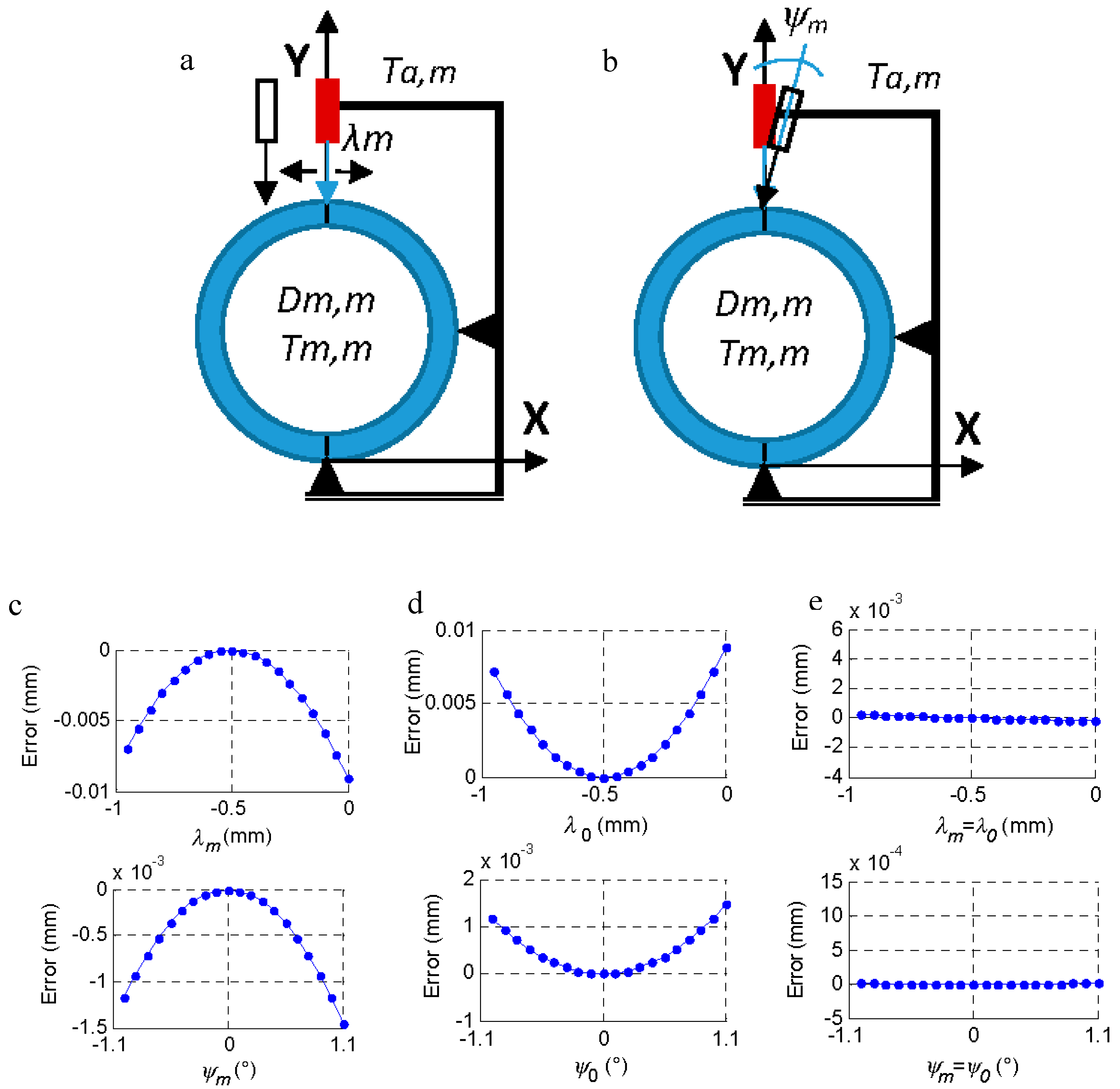
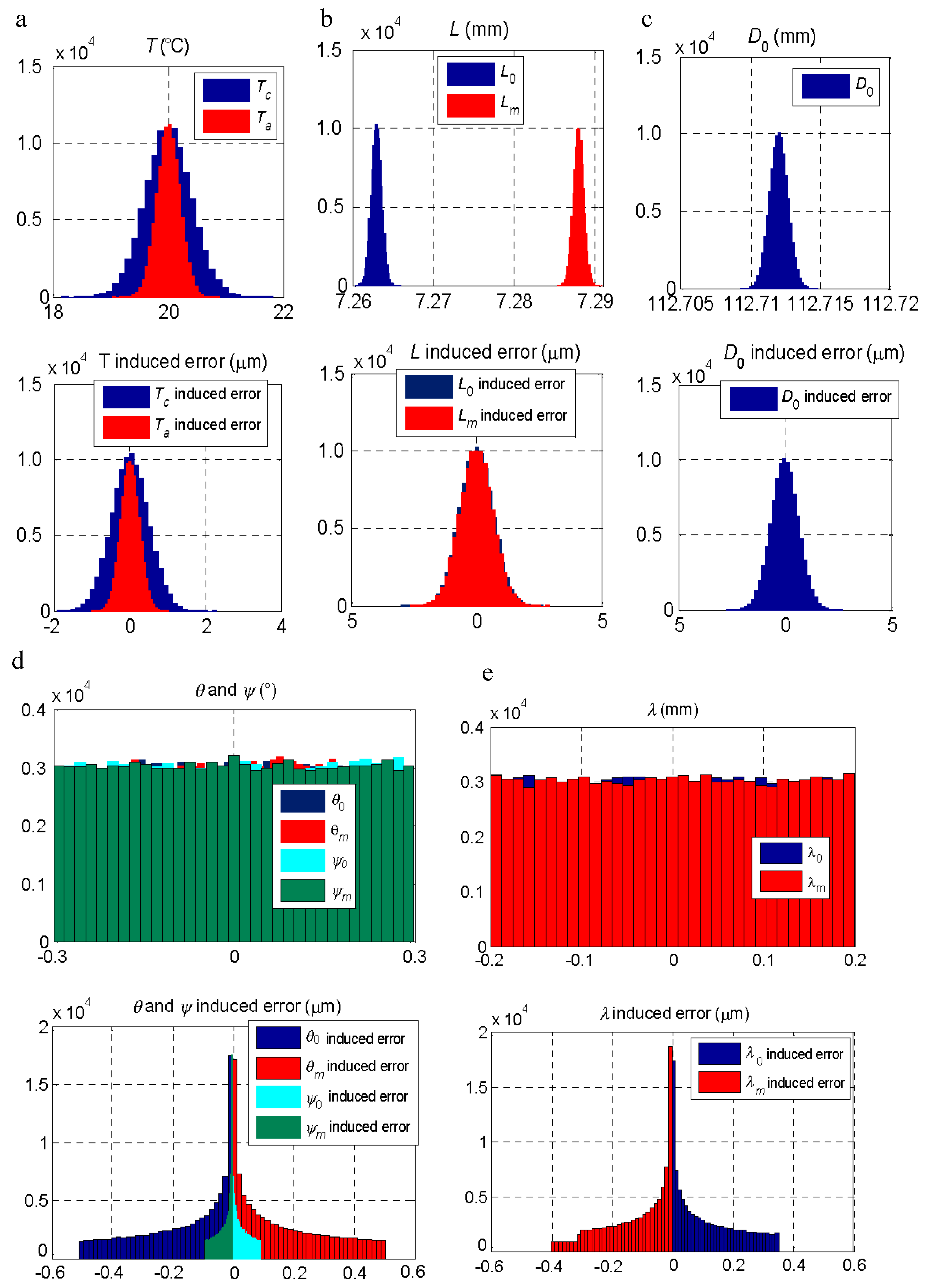
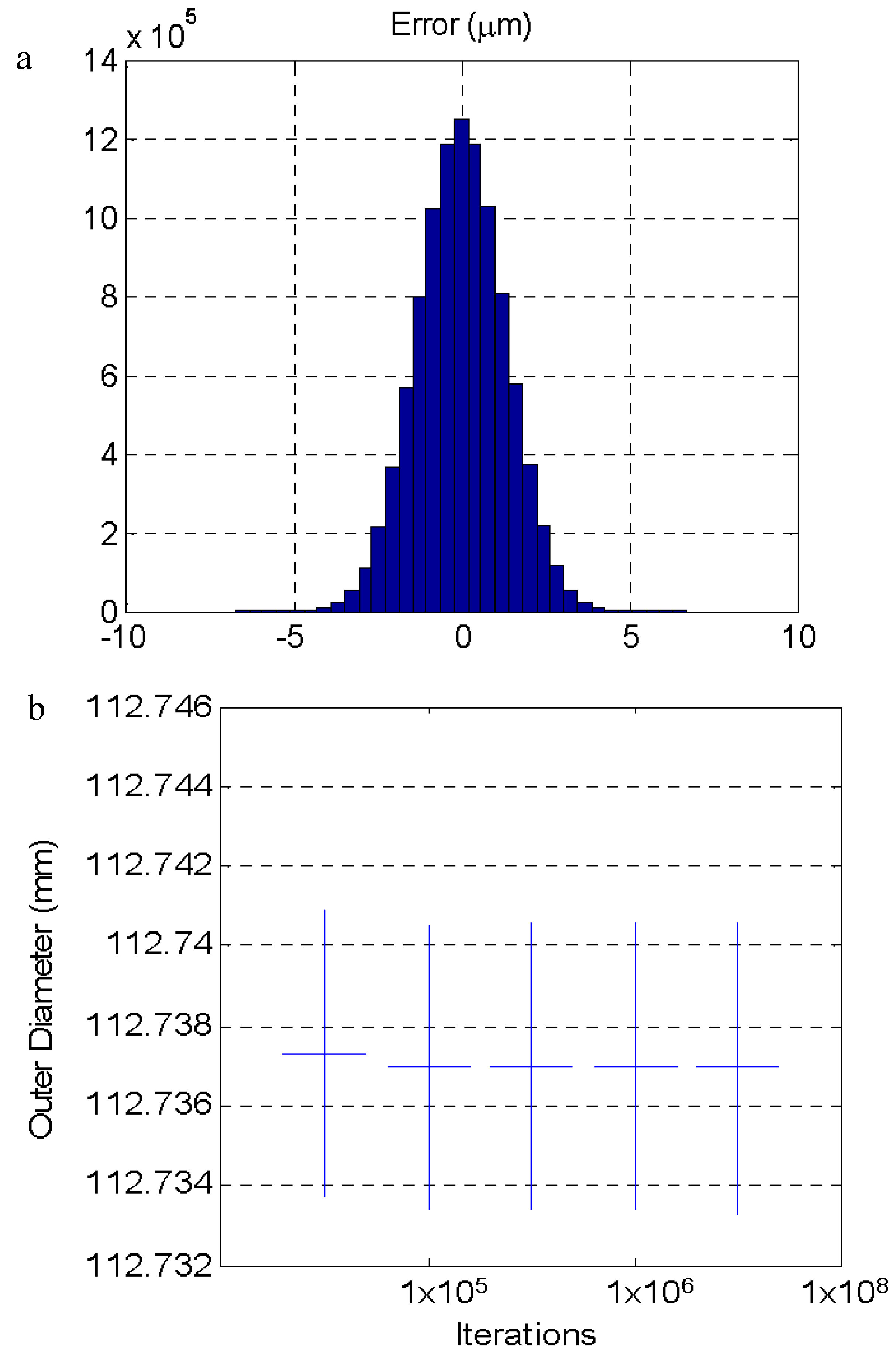

| Equipment | Range | Resolution | Expanded Uncertainty (k = 2) |
|---|---|---|---|
| Mechanical comparator (probe) | −1.5/+1.5 mm | 0.001 mm | 0.0013 mm |
| Contact probe thermometer | 0 a 250 °C | 0.1 °C | 0.39 °C |
| Thermocouple probe thermometer | −50 a 100 °C | 0.1 °C | 0.40 °C |
| Influencing Factors | Measurement System Elements (H, L, D) | ||||||||||||||
|---|---|---|---|---|---|---|---|---|---|---|---|---|---|---|---|
| T, temperature (°C) | Tx,t | t = m | t = 0 | H, tooling height (mm) | Hs,t | t = m | t = 0 | L, probe length (mm) | Lx,t | t = m | t = 0 | D, measurand (mm) | Dx,t | t = m | t = 0 |
| x = a | Ta,m | Ta,0 | Hs,m | Hs,0 | x = m | Lm,m | N.a. (1) | x = m | Dm,m | N.a. (1) | |||||
| x = s | Ts,m | Ts,0 | x = 0 | L0,m | L0,0 | x = 0 | D0,m | D0,0 | |||||||
| x = m | Tm,m | Tm,0 | H, tooling height at 20 °C | Lt, probe length at 20 °C | Dt, measurand at 20 °C | ||||||||||
| θt (°) | θm | θ0 | |||||||||||||
| ψt (°) | ψm | ψ0 | - | H | - | Lm | L0 | - | Dm | D0 | |||||
| λt (mm) | λm | λ0 | |||||||||||||
| Diameter (eq.) | Ta | Tc | ΔT for 0.025 mm Error (°C) |
|---|---|---|---|
| Dm with ambient and contact thermometer (16) | 1 | 1 | Not applicable |
| Dm w/o contact thermometer | 1 | 0 | 20.8 |
| Dm w/o ambient thermometer | 0 | 1 | 19.6 |
| Dm w/o any thermometer | 0 | 0 | 19.6 |
| Simulation Input Parameters | Simulation (106 Iterations) by Varying a Single Input Parameter | ||||
|---|---|---|---|---|---|
| Parameter | Equipment | Distribution | Measurement Uncertainty Um (k = 2) | Up. Limit | Low. Limit |
| Tc (°C) | Contact Therm. | Normal (µ = 30; σ = 0.39/2) | 0.0014 | 112.7356 | 112.7384 |
| Ta (°C) | Ambient Therm. | Normal (µ = 20; σ = 0.40/2) | 0.0007 | 112.7363 | 112.7377 |
| Lm, L0, D0 (mm) | Mech.probe | Normal (µ = 0; σ = 0.0013/2) | 0.0018 | 112.7352 | 112.7389 |
| θm (°) | Parameters of the measurement process and of the system whose variation is estimated with a uniform distribution | Uniform (U.L. = −0.003; L.L. = 0.003) | 0.0003 | 112.7365 | 112.7370 |
| θ0 (°) | 0.0003 | 112.7370 | 112.7375 | ||
| ψm (°) | Uniform (U.L. = −0.005; L.L. = 0.005) | 0.0000 | 112.7370 | 112.7371 | |
| ψ0 (°) | 0.0000 | 112.7369 | 112.7370 | ||
| λm (mm) | Uniform (U.L. = −0.2; L.L. = 0.2) | 0.0002 | 112.7370 | 112.7373 | |
| λ0 (mm) | 0.0002 | 112.7366 | 112.7370 | ||
| Simulation (106 iterations) varying all parameters | 0.0036 | 112.7334 | 112.7406 | ||
© 2018 by the authors. Licensee MDPI, Basel, Switzerland. This article is an open access article distributed under the terms and conditions of the Creative Commons Attribution (CC BY) license (http://creativecommons.org/licenses/by/4.0/).
Share and Cite
Brosed, F.J.; Zaera, A.V.; Padilla, E.; Cebrián, F.; Aguilar, J.J. In-Process Measurement for the Process Control of the Real-Time Manufacturing of Tapered Roller Bearings. Materials 2018, 11, 1371. https://doi.org/10.3390/ma11081371
Brosed FJ, Zaera AV, Padilla E, Cebrián F, Aguilar JJ. In-Process Measurement for the Process Control of the Real-Time Manufacturing of Tapered Roller Bearings. Materials. 2018; 11(8):1371. https://doi.org/10.3390/ma11081371
Chicago/Turabian StyleBrosed, Francisco Javier, A. Victor Zaera, Emilio Padilla, Fernando Cebrián, and Juan José Aguilar. 2018. "In-Process Measurement for the Process Control of the Real-Time Manufacturing of Tapered Roller Bearings" Materials 11, no. 8: 1371. https://doi.org/10.3390/ma11081371





